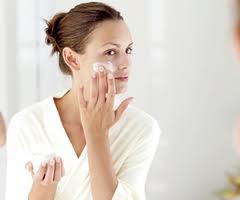Does Hair Color Really Cause Cancer?
An “Informed Beaute’s” right to know to Know
It is proven that hair dyes currently on the market may be hazardous to your health. Recent studies in toxicology have identified dangerous carcinogens and mutagens in certain types of coal tar hair dyes, and he European cosmetic regulatory body has confirmed the majority of hair dyes on the market, are linked to bladder cancer.
Recently, in 2008, the International Agency for Research on Cancer (IARC) concluded that hair dyes used in hair salons are very probable in the increase the risk of cancer. While results of the studies completed so far are inconsistent, many studies have shown an increased risk of bladder cancer, breast cancer and other health problems linked to the use of personal hair dye.
(Source: Cancer.gov http://www.cancer.gov/cancertopics/factsheet/Risk/hair-dyes).

Is Your Hair Coloring Product Toxic?
Not only do “other” hair coloring services strip away the natural moisture and oils from the hair and scalp, break down the hair shaft, but they also put your health at risk.
Kasia Organic Salon offers an alternative if you want to preserve your hair – and your health.
Toxic Compounds Found in Common Hair Coloring Products
Ammonia: A compound used in the chemical coloring process, ammonia can leave the hair looking dry, dull and brittle. Ammonia strips away the hair and scalp’s natural moisture and oils, and although it helps the synthetic color stick to the hair for longer, it is ultimately a toxic ingredient.
Say NO to Ammonia
* A strong irritant for skin, eyes and lungs.
* A suspected carcinogen.
Say NO to Ethanolamine (MEA)
* A toxicant for the immune, respiratory, reproductive, neurological & nervous systems.
* A carcinogen.
Resorcinol: A common ingredient found in synthetic hair coloring products, this compound can be absorbed through the skin. According to toxicology reports, short-term effects of resorcinol include irritation to the eyes, skin and respiratory tract, and long-term effects include the formation of methaemoglobin in the blood.
Proven Health Risks Associated with Hair Dyes
- Non-Hodgkin’s Lymphoma: The National Cancer Institute reports that 20 percent of all cases of non-Hodgkin’s lymphoma in women are the result of using permanent, chemical-laden hair coloring products on a regular basis
- Skin Allergies: Health line indicates that parabens such as propyl, methyl, butyl and ethyl – preservatives that are commonly used in hair color – are toxic and can cause an allergic reaction or other skin conditions.
- Bladder Cancer: A study published in the International Cancer Journal found that women who use permanent hair color may be more likely to develop bladder cancer than those that do not. COLIPHA, a European cosmetic regulatory body, has also confirmed that PPD found in hair dyes causes bladder cancer.
- Ovarian Cancer: The Harvard School of Public Health’s epidemiology department has found that women who undergo chemical hair processing more than five times per year are twice as likely to develop ovarian cancer as women who never use hair dye.
- Cancer of the Immune System: The American Cancer Society reports that people who use hair dye for two decades or more were at an increased risk of dying from cancers of the immune system, as well as multiple myeloma.
- Swollen Eyelids or Rashes: Kathleen Davis, an integrative dermatologist in New York City reported allergens can cause temporary swelling of the eyelids and rashes.
Allergic to Hair Color?
There are a growing number of phone calls coming into Kasia Organic Salon in complaint of common allergic reactions to hair dyes such as skin rashes, contact dermatitis, swelling of the face and neck, and irritation of the eyes, and headaches.
If you have experienced allergic reactions while sitting in the styling chair, it’s a relief to know you do have other options, not having to settle for discomfort and rashes, when you should relax, and enjoy your coloring service/investments
Kasia offers a number of benefits for people with allergies and hair coloring is one that “we wise women” do not wish to give up, it’s too fun!
Disclaimer: We always require a patch test, as this may not apply to everyone.
Ammonia Free & Long Lasting RESULTS?
There are several reasons to choose Ammonia Free color over chemical-laden lines available over the counter or at the hair salon.
Optimize your coloring results in avoiding chemicals that reduce the strength and integrity of your hair, increasing breakage, split ends, brittleness and fading.
YOUR RESULTS!
The Benefits of Kasia Salon Color Services
* Have a much more pleasurable experience at Kasia. No more: scalp stinging, itching, burning or marking.
* The colors have a strong, reduced-fade factor, since the cuticle (the outside layer of the hair) is largely returned to its original position.
* The hair has better shine and looks more natural.
* Excluding ethanolamine and other harmful ingredients.
* Achieve up to 5 levels of lift
* Unlimited possibilities with 60 shades
* Covers grey with uniform results
Hair Insurance!
Choosing the proper shampoos, conditioners and UV protected styling products will help prolong the life of color. We Love Hamadi Organics

Receive $20 Dollars OFF when you book your first Hair Color Service at Kasia Organic Salon!


 All the potential risks associated with chemicals in cosmetics make natural deodorants a lot more appealing.....
All the potential risks associated with chemicals in cosmetics make natural deodorants a lot more appealing.....








